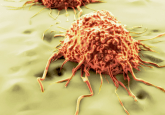New diagnostic technique identifies biomarker for bladder cancer

A new label-free and automated diagnostic technique, using digital Fourier transform infrared (FTIR) followed by proteomic analysis, has revealed the first protein biomarker, AHNAK2, for bladder cancer (BC). This biomarker accurately differentiates BC from benign inflammation and could help physicians make this challenging diagnostic decision in the future.
BC is the second most common urogenital malignancy, with approximately 75% of patients diagnosed with non-invasive, low-grade BC and the other 25% experiencing high-grade BC that infiltrates smooth muscle. Current measures for tumor grading and staging of BC are by visual inspection of stained tissue sections by a pathologist, or immunohistochemistry. However, these can be difficult to interpret, particularly in the presence of benign inflammation as some treatments for BC use pro-inflammatory agents.
“We developed this label-free digital pathology annotation system by IR imaging to support the pathologist, similar to driver assistance in cars. This technique in combination with a proteomics approach allowed us to identify AHNAK2 as an important new biomarker for BC, and the results encourage us to transfer this label-free digital technique to other pathologies,” commented Klaus Gerwert, Ruhr University (Bochum, Germany).
The new technique, detailed in the American Journal of Pathology, is able to classify unaltered tissue thin sections by color and identify regions of interest by applying label-free FTIR imaging. “The resulting index color images automates tissue classification, including cancer type, subtype, tissue type, inflammation status and even tumor grading,” Gerwert explained.
In the study, 103 freshly-frozen samples (including 41 confirmed diagnoses of cystitis, 19 low-grade carcinoma and 43 high-grade carcinoma) were analyzed by FTIR imaging. The results indicated that the technique was 95% more specific, sensitive and accurate when compared to stained images reviewed by a trained pathologist, and was able to differentiate between the healthy tissue, low- and high-grade carcinoma.
Homogenous tissue samples obtained by laser capture microdissection were then analyzed, and three potential biomarkers were identified that could distinguish between bladder inflammation (cystitis) and invasive, high-grade urothelial carcinoma – AHNAK2 showing the best performance. Further investigation was conducted on 310 freshly-frozen, paraffin-embedded tissue samples including 51 high-grade cancers, 84 low-grade cancers, 67 carcinoma in situ (CIS) and 108 patients with severe cystitis. The result showed 97% sensitivity and 69% specificity in differentiating between severe cystitis and CIS by AHNAK2 biomarker measurement.
“In our study, AHNAK2 was identified and verified in two steps as a candidate biomarker for BC,” explained Barbara Sitek, Ruhr University. “AHNAK2 has already been proposed as a potential prognostic biomarker for clear renal cell and pancreatic cancers and is part of a urinary mRNA panel for the diagnosis of BC and prediction of tumor aggressiveness.”
The researchers believe AHNAK2 has the potential to be a very useful diagnostic tool for identifying CIS recurrence and persistence in the future, allowing earlier treatment of aggressive malignancy and preventing unnecessary treatment or bladder removal in those suffering from inflammatory conditions.
Sources: Witzke KE, Großerueschkamp F, Jütte H et al. Integrated fourier transform infrared imaging and proteomics for identification of a candidate histochemical biomarker in bladder cancer. Am. J. Pathol. (2019); www.eurekalert.org/pub_releases/2019-02/e-ndt021119.php





